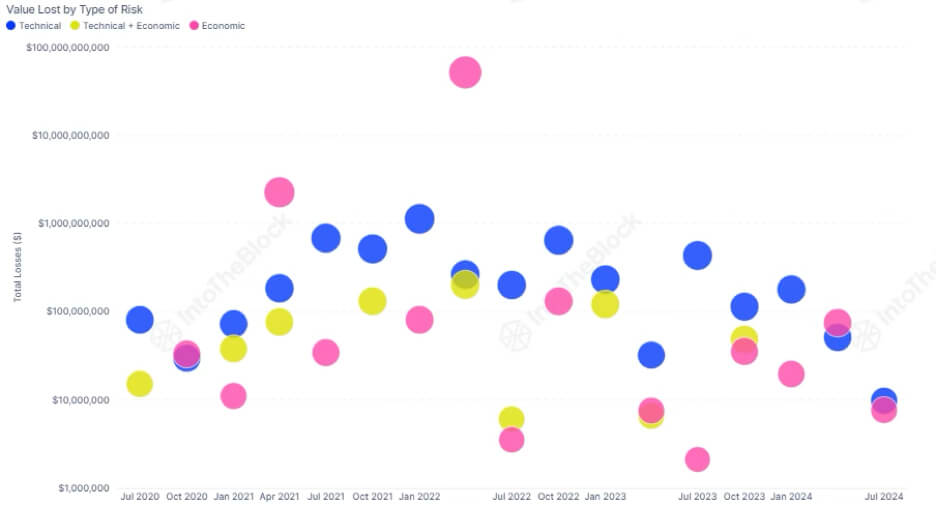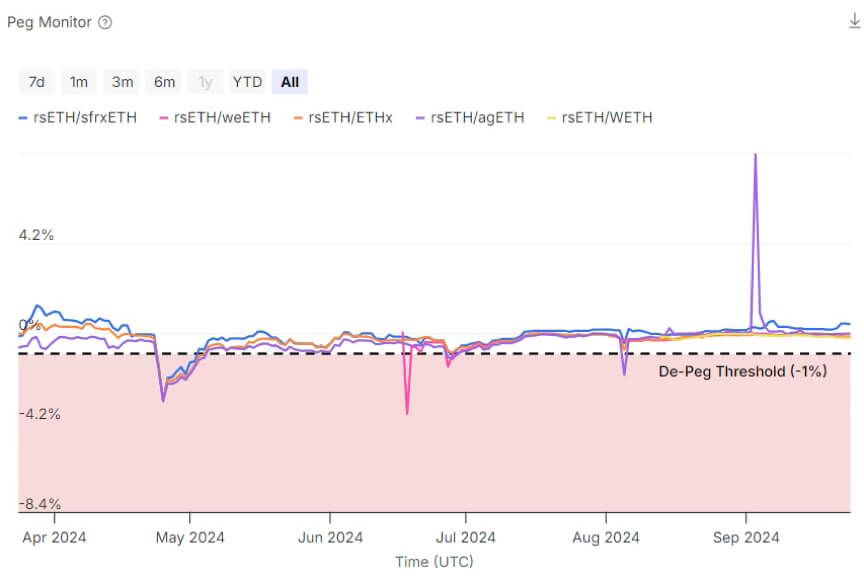

The following is a guest post from Vincent Maliepaard, Marketing Director at IntoTheBlock.
When discussing risks in DeFi, the conversation often turns to hacks and security breaches. This orientation is understandable, given the headlines and the sometimes dramatic consequences of such events. Hack analysis, post-mortem reports, and recommendations for best security practices dominate the conversation. However, while these discussions are crucial, they often overshadow a more insidious type of risk: economic risk.
Economic risks have led to nearly $60 billion in losses on DeFi protocols. Although this figure may seem high, it only reflects losses at the protocol level. The true total is likely much larger when individual user losses due to various economic risk factors are taken into account. These personal losses often result from volatile market conditions, complex protocol dependencies, and unexpected liquidations.

Understanding Economic Risk in DeFi
Economic risk in DeFi refers to the potential financial loss due to adverse movements in market conditions, liquidity crises, faulty protocol design, or external economic events. These risks are multiple and can come from various sources:
- Market risk: Volatility in asset values can lead to significant losses. For example, sudden declines in the prices of collateralized assets can trigger liquidations, leading to a cascade of forced sales and further price declines.
- Liquidity risk: The inability to quickly buy or sell assets without causing a significant impact on price. In DeFi, this can manifest during a market sell-off when liquidity pools dry up, exacerbating losses.
- Protocol risk: This risk arises from flaws or inefficiencies in the design of DeFi protocols. Ephemeral losses, oracle manipulation, and governance attacks are examples of how protocol-specific risks can materialize.
- External risk: Factors outside the protocol, such as actions of large market participants or changes in macro rates and conditions, can introduce significant risks that are often beyond the control of users or a protocol.
Layers of economic risk
In DeFi, economic risks are omnipresent, but they can be understood at two distinct levels: protocol-level risks and user-level risks. Distinguishing between the two helps users better define the risks affecting their strategies and monitor key signals to take preventive action.
Protocol level risks
The protocols implement safeguards through variable parameters designed to limit exposure to economic losses. A common example is lending and borrowing parameters defined by lending protocols, which are tested and calibrated to prevent the accumulation of bad debt. These measures are generally utilitarian, aimed at protecting the protocol from large-scale economic risks, for the benefit of the greatest number of users.
While managing economic risks are becoming more and more important To avoid large-scale losses at the protocol level, the focus is narrowed: on the protocol itself. They do not take into account the risks that individual users may introduce by making economically risky decisions as part of their own strategies.
User-level risks
User-level risks are often reduced to the amount of leverage an individual takes in long or short positions, but that only scratches the surface. Users face a range of additional risks, such as liquidations, fleeting losses, slippages and the risk of blocked loan liquidity. These individual risks are generally outside the scope of protocol risk management, but can have a significant financial impact on individual users.
The good news is that these user-level economic risks are highly exploitable. By understanding their own risk profile, users can actively manage and mitigate risks specific to their strategy. This personalized approach to risk management remains one of the most underutilized tools available to DeFi participants today.
The interconnected nature of risks in DeFi protocols
Economic risk management is essential to address risks that span multiple DeFi protocols. While protocol audits and risk settings strengthen individual protocols, DeFi users often engage with multiple protocols in their strategies. This makes risk management at the user level crucial.
Each additional protocol or asset introduces new risk factors, not only due to that new protocol, but also due to the way these protocols interact. Even though each protocol is secure on its own, risks can emerge from how your strategy combines these different protocols.
For example, imagine a scenario where a user uses a Liquid Restaking Token (LRT) as collateral to borrow an asset, which is then deployed into a liquidity pool (LP) on an external automated market maker (AMM). The main concern might be the leveraged borrowing position, but there are additional risks. The stability of the LRT peg could impact the liquidation of the loan protocol, while the composition of the LP could affect slippage and exit fees, potentially leading to a capital loss upon loan repayment. These interconnected risks are not within the control of any single protocol and are therefore best managed by the user.
Steps to Understanding and Managing Economic Risk
Managing economic risk in DeFi requires a thoughtful approach, as the complexity of multi-protocol strategies can introduce unforeseen vulnerabilities.
- Deep dive into protocol mechanics: Understanding the underlying mechanics of a protocol is the first step in identifying potential economic risks. Investors and developers should examine the business models, assumptions, and dependencies within the protocol.
- Monitor market indicators: It is essential to keep an eye on market signals, such as asset volatility, liquidity and general sentiment. Analyzing on-chain data specific to the protocols you use is a convenient way to stay informed. For example, if you are engaging in a lending strategy on Benqi, it is crucial to monitor the health factor of loans on the platform. This provides insight into the stability of your loan position and helps you anticipate potential problems before they become worse.


Source: https://defirisk.intotheblock.com/ - Create an overall risk profile: Understanding the impact of interconnected risks on your overall strategy is key to effective risk management. Although individual strategies vary, risk analysis can help identify areas of concern. For example, if you are using a Liquid Restaking Token (LRT) as collateral to borrow assets, it is essential to monitor the stability of the LRT peg to avoid unexpected liquidations. Sudden spikes or volatility in the peg could signal the need to take precautionary measures, such as reducing exposure or increasing collateral.


Source: https://defirisk.intotheblock.com/
In summary, managing economic risk in DeFi is about being proactive. By understanding protocol mechanics, closely monitoring market indicators, and establishing a holistic view of potential risks, users can better meet the challenges of multi-protocol strategies and protect their positions.






